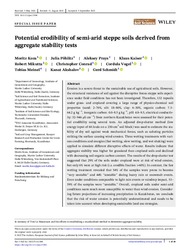Potential erodibility of semi‐arid steppe soils derived from aggregate stability tests
Pöhlitz, Julia
Prays, Aleksey
Meinel, Tobias
DOI: https://doi.org/10.1111/ejss.13304
Persistent URL: http://resolver.sub.uni-goettingen.de/purl?gldocs-11858/10457
Persistent URL: http://resolver.sub.uni-goettingen.de/purl?gldocs-11858/10457
Koza, Moritz; Pöhlitz, Julia; Prays, Aleksey; Kaiser, Klaus; Mikutta, Robert; Conrad, Christopher; Vogel, Cordula; Meinel, Tobias; Akshalov, Kanat; Schmidt, Gerd, 2022: Potential erodibility of semi‐arid steppe soils derived from aggregate stability tests. In: European Journal of Soil Science, Band 73, 5, DOI: 10.1111/ejss.13304.
 |
Dokument öffnen: |
Erosion is a severe threat to the sustainable use of agricultural soils. However, the structural resistance of soil against the disruptive forces steppe soils experience under field conditions has not been investigated. Therefore, 132 topsoils under grass‐ and cropland covering a large range of physico‐chemical soil properties (sand: 2–76%, silt: 18–80%, clay: 6–30%, organic carbon: 7.3–64.2 g kg−1, inorganic carbon: 0.0–8.5 g kg−1, pH: 4.8–9.5, electrical conductivity: 32–946 μS cm−1) from northern Kazakhstan were assessed for their potential erodibility using several tests. An adjusted drop‐shatter method (low energy input of 60 Joule on a 250‐cm3 soil block) was used to estimate the stability of dry soil against weak mechanical forces, such as saltating particles striking the surface causing wind erosion. Three wetting treatments with various conditions and energies (fast wetting, slow wetting, and wet shaking) were applied to simulate different disruptive effects of water. Results indicate that aggregate stability was higher for grassland than cropland soils and declined with decreasing soil organic carbon content. The results of the drop‐shatter test suggested that 29% of the soils under cropland were at risk of wind erosion, but only 6% were at high risk (i.e. erodible fraction >60%). In contrast, the fast wetting treatment revealed that 54% of the samples were prone to become “very unstable” and 44% “unstable” during heavy rain or snowmelt events. Even under conditions comparable to light rain events or raindrop impact, 53–59% of the samples were “unstable.” Overall, cropland soils under semi‐arid conditions seem much more susceptible to water than wind erosion. Considering future projections of increasing precipitation in Kazakhstan, we conclude that the risk of water erosion is potentially underestimated and needs to be taken into account when developing sustainable land use strategies.
Highlights
Organic matter is the important binding agent enhancing aggregation in steppe topsoils.
Tillage always declines aggregate stability even without soil organic carbon changes.
All croplands soil are prone to wind or water erosion independent of their soil properties.
Despite the semi‐arid conditions, erosion risk by water seems higher than by wind.
Statistik:
ZugriffsstatistikSammlung:
This is an open access article under the terms of the Creative Commons Attribution License, which permits use, distribution and reproduction in any medium, provided the original work is properly cited.

